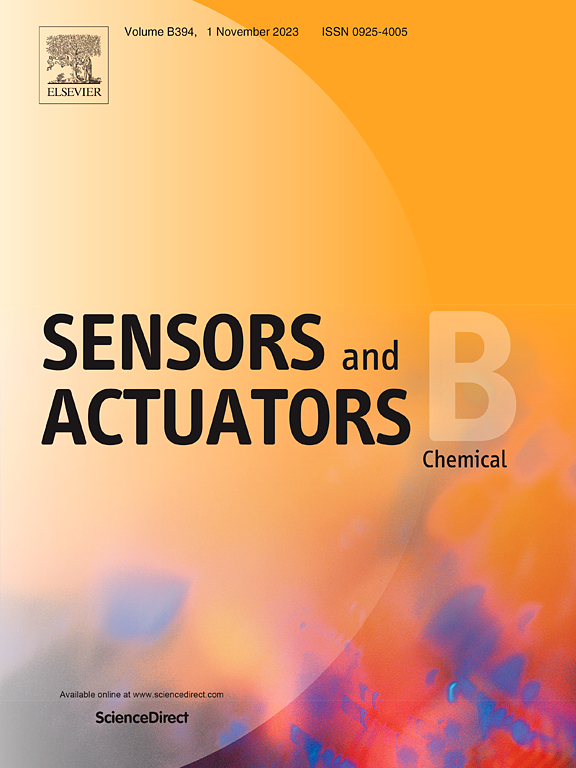蒸发驱动的金纳米棒Core@Silver壳复合材料的微图案通过表面增强拉曼散射实现痕量铯离子检测
IF 3.7
1区 化学
Q1 CHEMISTRY, ANALYTICAL
引用次数: 0
摘要
在本研究中,我们报告了一种强大且可扩展的策略,用于使用蒸发辅助微图像化技术制造金纳米棒core@silver壳(GNR@Ag)基表面增强拉曼散射(SERS)基板。所提出的方法通过控制沉积数量、衬底厚度和银壳涂层厚度来形成高度均匀和可重复的阵列。通过优化这些结构参数,我们实现了显著的拉曼信号增强,使分子分析物如罗丹明6g (R6G)和亚甲基蓝(MB)能够在很宽的浓度范围内进行痕量检测。值得注意的是,该平台表现出良好的信号线性和再现性,并在混合分析物环境中保持性能,支持其用于多路化学传感。除了对SERS底物进行物理优化外,还用葫芦b[6] (CB[6])对SERS底物进行了化学功能化,以提高其化学选择性。这种功能化策略导致铯离子(Cs +)信号选择性增强,而对其他重金属离子(如Hg 2 +和Zn 2 +)的响应可以忽略不计。该平台可以可靠地检测到纳米级的c⁺,突出了它在痕量污染物环境监测中的适用性。重要的是,几何控制的纳米结构和基于配体的表面化学的结合使得灵敏度和选择性的协同优化成为可能。总的来说,这项工作提出了一个全面的框架,用于设计多功能SERS衬底,精确控制结构和化学参数。提出的微图案GNR@Ag组件是便携式,高性能基于sers的传感器的有希望的候选者,用于复杂环境中痕量水平的检测和特定分析物的区分。本文章由计算机程序翻译,如有差异,请以英文原文为准。
Evaporation-driven micro-patterning of gold nanorod core@silver shell composites enables trace cesium ion detection through surface-enhanced Raman scattering
In this study, we report a robust and scalable strategy for fabricating gold nanorod core@silver shell (GNR@Ag)-based surface-enhanced Raman scattering (SERS) substrates using an evaporation-assisted micro-patterning technique. The proposed method enables the formation of highly uniform and reproducible arrays by controlling the deposition number, substrate thickness, and silver shell coating thickness. By optimizing these structural parameters, we achieved significant Raman signal enhancement, enabling the trace-level detection of molecular analytes such as Rhodamine 6 G (R6G) and methylene blue (MB) across a wide concentration range. Notably, the platform demonstrated excellent signal linearity and reproducibility, and maintained performance in mixed-analyte environments, supporting its utility for multiplexed chemical sensing. In addition to its physical optimization, the SERS substrate was chemically functionalized with cucurbit[6]uril (CB[6]) to improve chemical selectivity. This functionalization strategy resulted in selective enhancement of cesium ion (Cs⁺) signals, while showing negligible response to other heavy metal ions such as Hg²⁺ and Zn²⁺. The platform enabled reliable detection of Cs⁺ down to the nanomolar level, highlighting its applicability for environmental monitoring of trace contaminants. Importantly, the combination of geometrically controlled nanostructure and ligand-based surface chemistry allowed for synergistic optimization of sensitivity and selectivity. Overall, this work presents a comprehensive framework for designing multifunctional SERS substrates with precise control over both structural and chemical parameters. The proposed micro-patterned GNR@Ag assemblies are promising candidates for portable, high-performance SERS-based sensors targeting trace-level detection and discrimination of specific analytes in complex environments.
求助全文
通过发布文献求助,成功后即可免费获取论文全文。
去求助
来源期刊

Sensors and Actuators B: Chemical
工程技术-电化学
CiteScore
14.60
自引率
11.90%
发文量
1776
审稿时长
3.2 months
期刊介绍:
Sensors & Actuators, B: Chemical is an international journal focused on the research and development of chemical transducers. It covers chemical sensors and biosensors, chemical actuators, and analytical microsystems. The journal is interdisciplinary, aiming to publish original works showcasing substantial advancements beyond the current state of the art in these fields, with practical applicability to solving meaningful analytical problems. Review articles are accepted by invitation from an Editor of the journal.
 求助内容:
求助内容: 应助结果提醒方式:
应助结果提醒方式:


